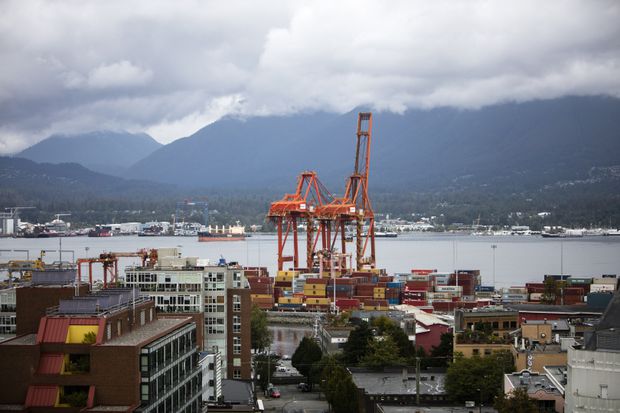
Port of Vancouver sends record numbers of empty shipping containers to Asia

The Port of Vancouver is sending record numbers of empty shipping containers to Asia, underscoring the chaotic effects of a recent recovery in global trade volumes.
Usually, shipping companies try to maximize cargo-carrying efficiency by keeping the reusable steel containers full in both directions of a voyage. When a boat unloads a shipping container of Asian import goods, the box is ideally refilled with Canadian export goods before it makes its return trip to Asia.
But, in the first eight months of this year, the volume of empty shipping containers leaving the Port of Vancouver soared, compared with the same period last year.
The reason so many shipping containers are going back to Asia filled with nothing but air has to do with a surge in consumer demand for Asian goods, as Canadians resume spending after an early-pandemic lull. Rather than waiting for the containers to be loaded with Canadian goods, shipping companies are paying for them to be sent to Asia empty, so that they can be filled faster for the trip back to Canada, said Robin Silvester, chief executive officer of the Vancouver Fraser Port Authority.
The pursuit of the scarce metal boxes by Asian shippers has made it more difficult for exporters based in Canada to get their hands on containers.
“It’s a symptom of the congestion in the supply chain,” Mr. Silvester said. “When you see the surges in the supply chain that we’re seeing at the moment, shipping lines just want to get those boxes back to Asia.”
Container trade is tracked through an industry measurement called TEUs (20-foot-shipping-container equivalent units). There were 597,443 TEUs of empty containers exported fromVancouver in the first eight months of this year, up 89 per cent from the same period in 2020. And 2020 was previously the record-high year for empty-container shipments from the port.
Almost half of all the containers that have left Vancouver so far this year have been empty.
In total, the Port of Vancouver has handled 2.55 million TEUs of both imports and exports during the first eight months of 2021, up 17 per cent from the same period in 2020.
China is the largest shipper into the Port of Vancouver of containerized merchandise, including consumer goods. And China is also Canada’s largest customer for exports of wheat and specialty crops, which are mostly transported as bulk cargoinside the hulls of ships, but can also be sent inside containers.
The problems with container logistics are not limited to Canada. Port congestion is worsening around the world as the global supply chain reacts to an increase in trade after 2020′s pandemic-induced lows.
“Carriers prefer to reposition empty boxes instead of laden boxes to reduce the turnaround time,” DHL Global Forwarding said in a recentpresentation to its clients.
Expanding Vancouver’s port capacity could provide some relief, but efforts to do so are still months or years away from producing results.
Dubai-based DP World PLC, which operates the Centerm terminal at Burrard Inlet along Vancouver’s waterfront, plans to add 600,000 TEUs of annual capacity, for a total of 1.5 million TEUs by mid-2022. Construction of the expansion, which is expected to cost $454-million, is forecast to be 90 per cent complete by the end of this year.
Mr. Silvester is hoping the federal cabinet will rule by the end of March on the Port of Vancouver’s plans for a new $3.5-billion container terminal to be located near Delta, B.C., about 30 kilometres south of Vancouver.
The port is touting the project, called Roberts Bank Terminal 2 (RBT2), as a crucial expansion of shipping-container capacity on the West Coast to meet an anticipated increase in trans-Pacific traffic, including imports of consumer goods from Asia.
RBT2 would require construction of an artificial island near an existing coal-export terminal and shipping-container site. “The reason we’re moving RBT2 forward is we did a thorough analysis and have done a huge amount of environmental work over the course of 10 years. And it continues, based on all that work, in our view, to be the best opportunity to create critical capacity for Canada,” Mr. Silvester said.
Even with the Centerm expansion underway, the Port of Vancouver’s administrators are worried that Canada’s West Coast will run out of space to handle additional container shipments as early as 2025. “That’s actually kind of scary, because we can’t create capacity that quickly,” Mr. Silvester said. “So it really just underlines the importance of getting [RBT2] to move forward and creating that capacity. Otherwise, Canada is running out of capacity for containers, and that’s a problem for all of us.”
RBT2, however, is facing opposition from one of the port’s own tenants, GCT Global Container Terminals Inc., which runs an existing shipping-container site near Delta.
While the port’s hope is to open RBT2 in 2030, GCT has argued that its proposed Deltaport 4 expansion,which would add a fourth berth to its own facility, is a much better solution for supplying extra container capacity in the long term.
GCT has forecasted a total cost of $1.6-billion to add two million TEUs of annual container capacity at its facility.RBT2 would add 2.4 million TEUs for more than twice the estimated price.
GCT’s proposal is undergoing a review by the Impact Assessment Agency of Canada and the B.C. Environmental Assessment Office.
The Port of Vancouver is the landlord for container terminals at DP World’s Fraser Surrey Docks operation and GCT’s Vanterm facility. In Prince Rupert, DP World operates the Fairview container site.

